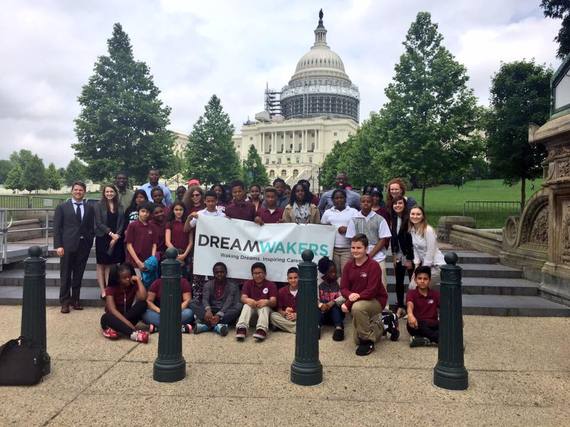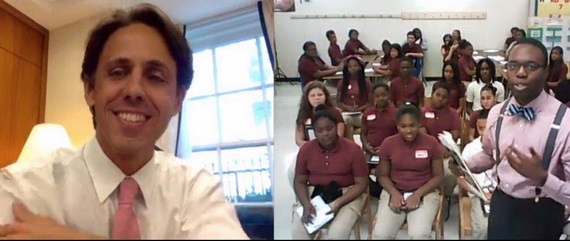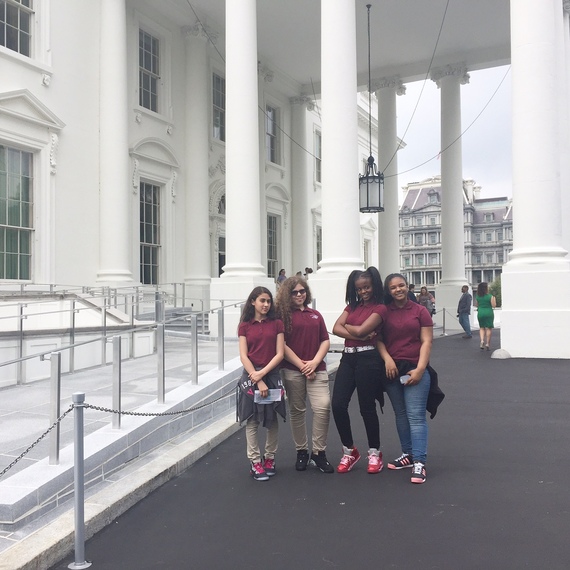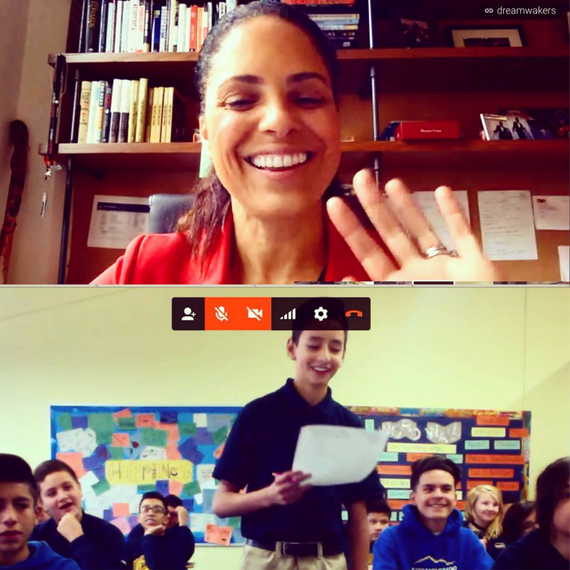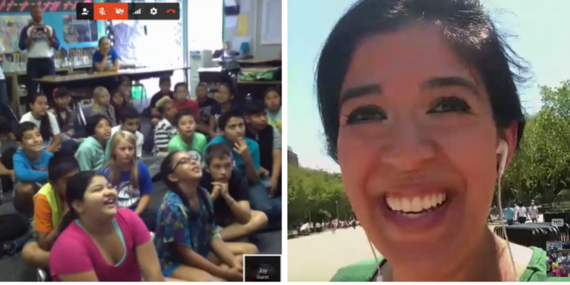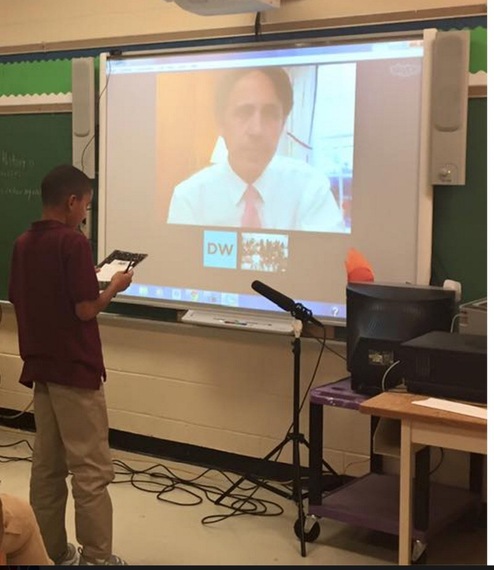On June 3rd, 2016 I took a road trip to the White House with 38 seventh-graders from Newark, NJ, and it's a day that I'll never forget.
How did the trip come about? Let me provide a bit of background: I run DreamWakers, an education nonprofit that harnesses the power of free video chats to bring diverse and dynamic leaders into high-need schools. Working in communities nationwide, our 45-minute "flashchats" connect 4th-12th grade classrooms with professionals including journalists, entrepreneurs, Senators, and 3-D printing pros. Our goal is to help shed light on how students' class work will help them in the real world, and to inspire them by facilitating interaction with role models they would never otherwise get to meet.
Video Credit: Marquise Richards, DreamWakers Digital Media Intern
Last fall, a fifth grade Teach for America Social Studies teacher in Newark, NJ, Mr. Ojeikere (aka "Mr. O"), submitted a request on our website for a speaker to give his kids some personal and professional encouragement. "My students are from a Latin-American and African-American community," he said. "They love to learn and they love opportunities, but at the same time I feel like they are missing some inspiration that I am not able to currently give." School budgets were tight, he explained, and bringing guest speakers into the classroom -- mentors the children would relate to and click with -- was a challenge.
DreamWakers immediately set to work. Using Skype and Google Hangouts, we connected Mr. O's students with African American leaders at the U.S. Department and with White House Political Director David Simas. A son of Portuguese-immigrant factory workers, Simas described his experience speaking to those students as "one of the best things" he's done during his time at the White House. He even extended an invitation for the entire class to visit 1600 Pennsylvania Avenue.
And visit the White House they did. Mr. O's students, fellow teachers, and our NYC-based DreamWakers team loaded onto a bus in Newark at 6 a.m and headed through rain and traffic to our nation's capital. It was a trip unlike any other. In the days since, I've reflected a great deal on the experience, and have come away with three lessons.
1. Field trips are fantastic -- especially for high-need students -- but they're simply not scalable.
Field trips are fabulous, and they can have a particularly positive impact on students from high-need communities. In one University of Arkansas study, for example, researchers evaluated 10,912 students and 489 teachers at 123 different American schools and found that the benefits of a field trip are consistently much larger for students from less-advantaged backgrounds.
This is one of the reasons why DreamWakers puts a particular focus on bringing flashchats to students in high-need areas; in fact, approximately 70 percent of our schools have more than 50 percent of their students on free and reduced lunch, with most coming from rural and urban communities across the country. And only 16 percent of our partner classrooms were previously exposed to a speaker outside of their city limits before engaging with DreamWakers.
One obvious obstacle schools face in planning field trips is cost. In helping to coordinate this White House field trip, I was shocked at how expensive it was and how quickly the costs -- transportation, insurance, food -- added up. Such expenses can strain budgets. What's more, one must factor in the opportunity cost and what's lost when a student misses an entire day of classes.
Luckily, despite the constraints around physical field trips, teachers today have low-cost, high-impact alternatives at their disposal. Through DreamWakers, for instance, teachers can provide free virtual field trips through real-time discussions with professionals at places such as the White House, State Department, or Facebook. For example, while hosting her first flashchat in May, Facebook Sales Executive Bianca Gates took 4th grade students in Chicago, Ill., on a virtual tour of the Facebook campus in Menlo Park, CA.
These interactions with a wide array of professionals are a critical component to addressing a growing problem in workforce development, a phenomenon called career "undermatching." As Opportunity Network CEO Jessica Pliska explained in a recent article, "Nobody tells these young people about the wide array of career options they can explore or introduces them to professionals who can show them around workplaces." This is why virtual virtual field trips are essential: they provide a simple and scalable way to bring a world of possibility into public school classrooms.
2. Relatable Role Models = Priceless.
Connecting our underserved youth to real-world role models is critical. While education is the key to American advancement, unfortunately career opportunities largely depend on how and where you grew up. This opportunity gap begins to widen early on. Affluent children spend 1,300 more hours than low-income children before age 6 in places other than their homes, their day care centers, or schools (anywhere from libraries and museums to public transit and athletic fields), reports Meredith Phillips, an associate professor of public policy and sociology at the University of California, Los Angeles. Such out-of-home experiences give affluent children a leg up in career exposure from the very first day of kindergarten.
As time passes, the chasm only widens: More than a million students drop out of high school each year; that's one student every 26 seconds, according to the U.S. Department of Education. Only 9% of students from the lowest income bracket graduate college, compared to 77% students from families in the top income quartile, according to a University of Pennsylvania study.
Students can't be what they can't see.
The question, then, is how do we keep students focused on their educations and, ultimately, their futures? Students can't be what they can't see; they need engage with positive role models with whom they can relate.
For example, after an international business executive from the Bronx virtually connected with a class in his hometown through DreamWakers, a student said, "He knows the struggle we face on a daily basis with peer pressure, violence in the communities and household issues." The young man added, "I became inspired to not follow the crowd because they can be the reason why I might postpone my dreams and let opportunities go."
Teachers see the immediate impact of their students meeting such role models. A teacher based in El Jon, Calif., wrote to DreamWakers that she worked at a "Title 1, socioeconomically disadvantaged school with a high concentration of both Hispanic and Middle Eastern students." She wanted to connect the class to a role model with whom the students could relate. Last Friday DreamWakers introduced her class to Iraqi-American White House Correspondent Yasmeen Alamari of Rare Politics, who took the students on a virtual field trip to the White House Press Briefing Room and the Eisenhower Executive Office Building. That night, Ms. Delgallego wrote: "Thank you for the most wonderful opportunity I have ever been able to provide my students in my 10 years of teaching."
Newark teacher Mr. O, whose students I accompanied to the White House, put it like this: "When you're teaching a class many times you'll have students read a speech or an interview discussing the importance of education and pursuing one's goals for a better future. But when someone like Mr. Simas tells these kids something -- when they they get to speak with someone who looks like them, has had similar experiences as them...these kids light up. They get inspired."
Inspired students are more alert and more eager to learn. At DreamWakers, we've seen again and again how connecting students to relatable role models can provide that spark of inspiration.
3. A virtual meeting can actually change lives.
I find it perplexing that half of employers don't believe that students are prepared for work, yet two-thirds of employers have little to no interaction with schools. What's more, 65 percent of today's students will be employed in jobs they don't even yet exist. Little improvement can be expected in our education system if we don't close the gap that exists between classrooms and careers.
Through virtual flashchats, the workforce and education community are empowered to join forces to help bring about real and positive change. At DreamWakers, our flashchats don't end at 45 minutes when the speaker exits the virtual discussion: Nearly all -- 93 percent -- of classrooms continue to discuss the topics and lessons learned in the flashchat in the days following.
As Joyce McCree, a Newark educator who accompanied the students of Alma Flagg School to the White House put it: "The rich engagement that occurs when students participate in virtual conversations becomes a springboard for further learning and a motivating factor as students move forward."
With the White House trip a few weeks behind me, I have been pondering the importance of exposing those 38 young people to such an amazing real-life experience in our nation's capital. I know there is no way we could give every student across the United States such an opportunity. Yet, with modern technology, DreamWakers has the tools to serve not just 38 but 38 thousand or even 38 million students -- by bringing a best-selling author, a tech CEO, even a top White House official, directly to their classrooms.
--
Monica Gray is Co-Founder & CEO of DreamWakers.
Teachers, apply to host a virtual DreamWakers flashchat.
Companies, email info@dreamwakers.org to learn about DreamWakers Corporate Sponsorship Program.

